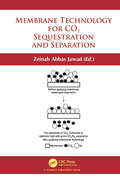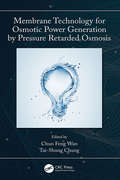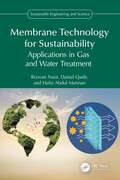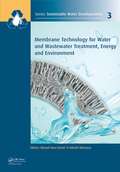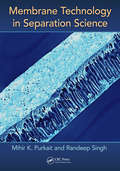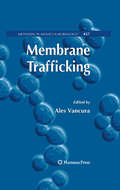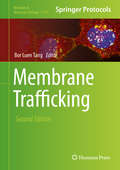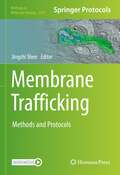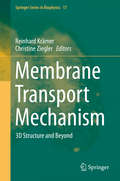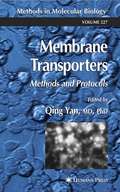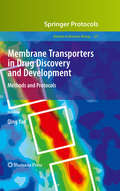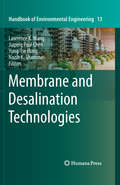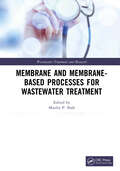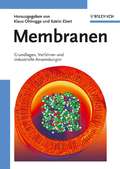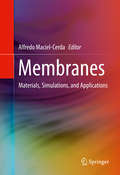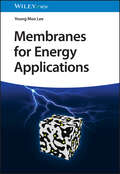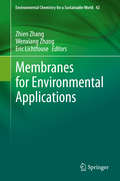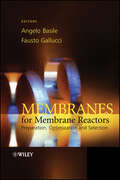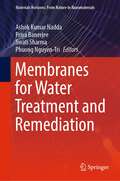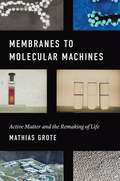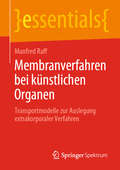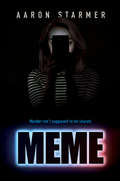- Table View
- List View
Membrane Technology for CO2 Sequestration
by Zeinab Abbas JawadThis book addresses the fundamentals of CO2 storage for long-term sequestration in a subsurface geologic formation. In general, membrane gas separation can find a large room of application in flue gas. To achieve the development of this technology on a larger scale than which is possible in the lab we have to use membrane engineering. Consequently, greater emphasis is placed on novel materials for gas separation. Possible design strategies and role of novel materials are discussed. Additionally, the latest progress in design and preparation of asymmetric membranes for natural gas purification are highlighted. In fact, further development should focus on module and process design in order to bring gas separation membrane technology into commercial application. Therefore, the keys issues to propel current research towards industrial application are examined. Besides, the feasibility of implementing polyimide membrane for CO2 removal under real industrial conditions and its economic viability are highlighted. In order to exhibit excellent film-forming properties, zeolite membrane and cellulose acetate butyrate membrane areaddressed. Interestingly, it was found that the most accurate theoretical three-phase model is arguably revised Pal model with average percentage error of 0.74%.
Membrane Technology for Osmotic Power Generation by Pressure Retarded Osmosis
by Tai-Shung Chung Chun Feng WanOsmotic energy can be effectively harvested through pressure retarded osmosis (PRO) which is the most widely investigated technology due to its greater efficiency and higher power density output and effective membranes are the heart of the PRO technology. This book will cover a broad range of topics, including PRO membranes, fouling, module fabrication, process design, process operation and maintenance. It summarizes the progress in PRO researches in the last decade, and points out the directions for future R&D and commercialization of PRO. It will be of great interest to membrane researcher, company and operators to understand and get insights into the state-of-the-art PRO technologies.
Membrane Technology for Sustainability: Applications in Gas and Water Treatment (Sustainable Engineering and Science)
by Rizwan Nasir Danial Qadir Hafiz Abdul MannanThis book is a comprehensive assessment of the pivotal role that membrane technology plays in addressing ongoing environmental and sustainability challenges. It covers various aspects of membrane technology, with a focus on gas separation and water treatment membranes, and explains their principles, design, and applications. Readers interested in sustainable engineering will learn about membrane materials, fabrication techniques, performance optimization, and system integration, along with a holistic perspective on the capabilities and limitations of membranes. This book presents real-world case studies and success stories, highlighting the practical implementation of membrane technologies in various industries.Features: Explains the use of membrane technology and its transformative potential for a greener and more resilient environment. Discusses membrane technology and its applications in gas and water treatment. Includes case studies that illustrate the performance of membrane processes in different applications with regard to sustainability. Provides insights into the challenges and opportunities of using membrane technology to improve gas and water treatment. Includes information on new membrane materials, processes, applications, and future trends. This book is a great reference for researchers and graduate students in environmental engineering, water engineering, and chemical engineering. It is also an excellent resource for environmental engineers and professionals in the water and gas industry interested in sustainability.
Membrane Technology for Water and Wastewater Treatment, Energy and Environment (Sustainable Water Developments - Resources, Management, Treatment, Efficiency and Reuse)
by Takeshi Matsuura Ahmad Fauzi IsmailRealizing that water, energy and food are the three pillars to sustain the growth of human population in the future, this book deals with all the above aspects with particular emphasis on water and energy. In particular, the book addresses applications of membrane science and technology for water and wastewater treatment, energy and environment. Th
Membrane Technology in Separation Science
by Mihir K. Purkait Randeep SinghThe book explains fundamental and advanced topics related to the field of membrane science including extensive coverage of material selection, preparation, characterization and applications of various membranes. <P><P>Explores both preparation and wide range of applications for all possible membranes, contains an exclusive chapter on functionalized membranes and incorporation of stimuli responsive membranes in each type and includes exercise problems after each chapter <P><P>It also discusses new membrane operations as membrane reactors and membrane contactors
Membrane Technology, Volume 3: Membranes for Food Applications, 1st Edition
by Klaus-Viktor Peinemann Lidietta Giorno Suzana Pereira NunesEdited by an internationally recognized leader in the field, this third volume in the series represents the complete reference to membrane processes in the food industry. The handbook adopts a highly practical approach to this hot topic, combining the hands-on experience of the expert authors involved. They provide chapters devoted to such varied applications as dairy fractionation, electrodialysis, pressure-driven membrane processes in alcoholic beverages, membrane emulsification, contactors and bioreactors, as well as membranes for food packaging.
Membrane Technology: Sustainable Solutions in Water, Health, Energy and Environmental Sectors
by Sundergopal SridharContributed by multiple experts, the book covers the scientific and engineering aspects of membrane processes and systems. It aims to cover basic concepts of novel membrane processes including membrane bioreactors, microbial fuel cell, forward osmosis, electro-dialysis and membrane contactors. Maintains a pragmatic approach involving design, operation and cost analysis of pilot plants as well as scaled-up counterparts
Membrane Trafficking
by Ales VancuraAs membrane trafficking research has expanded over the past thirty years, a remarkable convergence of information has been gained by using genetic approaches in yeast cells with biochemical approaches in mammalian cells. This book reflects these advances by devoting one section of the book to yeast cells and the other to mammalian cells, with each section providing both classic and cutting-edge techniques to study macromolecular transport across the membranes.
Membrane Trafficking
by Bor Luen TangThis second edition explores membrane trafficking research that has been at the frontier of cell and molecular biology. In the past 20 years, this field has witnessed a remarkable convergence and synergism from information gained using genetic approaches in yeast cells, and biochemical and molecular approaches in mammalian cells. This volume contains updated chapters and the inclusion of a large number of new chapters, and is divided into three parts. Part I includes biochemical and molecular genetics approaches and methods used in analysing membrane traffic, in both yeast and mammalian cell models. Part II focuses on imaging and microscopy approaches and techniques, while Part III highlights the Omics-type approaches. Written in the highly successful Methods in Molecular Biology series format, chapters include introductions to their respective topics, lists of the necessary materials and reagents, step-by-step, readily reproducible laboratory protocols, and tips on troubleshooting and avoiding known pitfalls. Cutting-edge and resourceful, Membrane Trafficking, Second Edition, is a valuable resource for both experienced researchers, graduate students, and junior scientists in the field of membrane trafficking.
Membrane Trafficking: Methods and Protocols (Methods in Molecular Biology #2473)
by Jingshi ShenThis detailed volume presents a series of methods exploring membrane trafficking research, ranging from genetics and high-resolution imaging to in vitro biochemical and biophysical assays. Covering virtually all the major trafficking branches, the book delves into the exocytic pathway, which focuses on cargo transport from the ER to the Golgi, through the Golgi cisternae, and to the plasma membrane and the extracellular space; the endocytic pathway, which includes cargo endocytosis, endosomal recycling, and lysosomal degradation; as well as emerging topics beyond the conventional exocytic and endocytic pathways. Written for the highly successful Methods in Molecular Biology series, chapters include introductions to their respective topics, lists of the necessary materials and reagents, step-by-step, readily reproducible laboratory protocols, and tips on troubleshooting and avoiding known pitfalls. Authoritative and practical, Membrane Trafficking: Methods and Protocols provides techniques with broad applications as an ideal guide for junior researchers new to membrane trafficking as well as established membrane biologists seeking to expand their research programs.
Membrane Transport Mechanism
by Christine Ziegler Reinhard KrämerThis book provides a molecular view of membrane transport by means of numerous biochemical and biophysical techniques. The rapidly growing numbers of atomic structures of transporters in different conformations and the constant progress in bioinformatics have recently added deeper insights The unifying mechanism of energized solute transport across membranes is assumed to consist of the conformational cycling of a carrier protein to provide access to substrate binding sites from either side of a cellular membrane. Due to the central role of active membrane transport there is considerable interest in deciphering the principles of one of the most fundamental processes in nature: the alternating access mechanism This book brings together particularly significant structure-function studies on a variety of carrier systems from different transporter families: Glutamate symporters, LeuT-like fold transporters, MFS transporters and SMR (RND) exporters, as well as ABC-type importers The selected examples impressively demonstrate how the combination of functional analysis, crystallography, investigation of dynamics and computational studies has made it possible to create a conclusive picture or more precisely, "a molecular movie". Although we are still far from a complete molecular description of the alternating access mechanism, remarkable progress has been made from static snapshots towards membrane transport dynamics.
Membrane Transporters
by Qing YanThis collection of cutting-edge methodologies for studying membrane transporters and channels takes advantage of all the latest developments in biomedical research, including pharmacogenomcs, bioinformatics, and microarray technologies. The authors explain databases and tools for bioinformatics studies, provide practical guidelines for microarray experiments and data analysis, and illustrate the use of small angle X-ray scattering, nuclear magnetic resonance (NMR), and molecular modeling to study the structural biology of membrane transporters. Methods for exploring structure-function correlation, such as site-directed mutagenesis, immunocytochemistry, and confocal microcopy are also described, along with several that may help in the development of novel therapeutics.
Membrane Transporters in Drug Discovery and Development
by Qing YanStudies of membrane transporters have had a great impact on our understanding of human diseases and the design of effective drugs. In Membrane Transporters in Drug Discovery and Development: Methods and Protocols, expert researchers provide practical methodologies of the ongoing research on membrane transporters, considering applications of transporter technologies in drug discovery and development. Chapters include new and useful fields and methodologies, including pharmacogenomics, nutrigenomics, systems biology, bioinformatics, nuclear magnetic resonance (NMR), imaging, and quantitative real-time-PCR. Transporter studies in drug discovery and development for various diseases are discussed, including neuropsychiatric disorders, cardiovascular diseases, ophthalmic diseases, cancer, and diabetes. Composed in the highly successful Methods in Molecular BiologyTM series format, each chapter contains a brief introduction, step-by-step methods, a list of necessary materials, and a Notes section which shares tips on troubleshooting and avoiding known pitfalls. Wide-ranging and current, Membrane Transporters in Drug Discovery and Development: Methods and Protocols delivers a collection of practical protocols that can be used immediately in the lab, along with critical surveys of key topics by leading researchers in the field.
Membrane and Desalination Technologies
by Lawrence K. Wang Yung-Tse Hung Nazih K. Shammas Jiaping Paul ChenIn this essential new volume, Volume 13: Membrane and Desalination Technologies, a panel of expert researchers provide a wealth of information on membrane and desalination technologies. An advanced chemical and environmental engineering textbook as well as a comprehensive reference book, this volume is of high value to advanced graduate and undergraduate students, researchers, scientists, and designers of water and wastewater treatment systems. This is an essential part of the Handbook of Environmental Engineering series, an incredible collection of methodologies that study the effects of pollution and waste in their three basic forms: gas, solid, and liquid. Chapters adopt the series format, employing methods of practical design and calculation illustrated by numerical examples, including pertinent cost data whenever possible, and exploring in great detail the fundamental principles of the field. Volume 13: Membrane and Desalination Technologies is an essential guide for researchers, highlighting the latest developments in principles of membrane technology, membrane systems planning and design, industrial and municipal waste treatments, desalination requirements, wastewater reclamation, biofiltration, and more.
Membrane and Membrane-Based Processes for Wastewater Treatment (Wastewater Treatment and Research)
by Maulin P. ShahThe proposed book mainly sorts out emerging and burning issues faced day to day by municipal and industrial wastewater treatments. It also provides a comprehensive view of recent advances in hybrid treatment technologies for wastewater treatment, addresses the current limitations and challenges of applying these tools in wastewater treatment systems. This book gives an insight about recent developments in membrane technology for wastewater treatment. Industrial wastewater contains a large variety of compounds, such as heavy metals, salts and nutrients, which makes its treatment challenging. Thus, the use of conventional water treatment methods is not always effective. In this sense, membrane-based hybrid processes have emerged as a promising technology to treat complex industrial wastewater. The present book analyses and discusses the potential of membrane-based hybrid processes for the treatment of complex industrial wastewater along with the recovery of valuable compounds and water reutilization. In addition, recent and future trends in membrane technology are highlighted. FEATURES 1. The properties, mechanisms, advantages, limitations and promising solutions of different types of membrane technologies are discussed. 2. The optimization of process parameters is addressed. 3. The performance of different membranes is described. 4. The potential of nanotechnology to improve the treatment efficiency of wastewater treatment plants is presented. 5. The application of membrane and membrane-based hybrid treatment technologies for wastewater treatment is covered.
Membrane-Distillation in Desalination
by Farid BenyahiaMembrane-Distillation in Desalination is an attempt to provide the latest knowledge, state of the art and demystify outstanding issues that delay the deployment of the technology on a large scale. It includes new updates and comprehensive coverage of the fundamentals of membrane distillation technology and explains the energy advantage of membrane distillation for desalination when compared to traditional techniques such as thermal or reverse osmosis. The book includes the latest pilot test results from around the world on membrane distillation desalination.
Membranen: Grundlagen, Verfahren und Industrielle Anwendungen
by Grundlagen Verfahren und industrielle AnwendungenVon der Membran zum Verfahren - Der Einsatz von Membranverfahren in der chemischen Industrie weitet sich ungebremst aus. Als saubere und energiesparende Alternative zu herkömmlichen Trennverfahren halten die Membranverfahren weiterhin Einzug in vielfältige industrielle Anwendungen. Fest eingeführt sind solche Verfahren u. a. in der Gastrennung und der organophilen Filtration, und neue Perspektiven eröffnen sich für katalytische Reaktionen in Membranreaktoren. Die Membrantechnik ist die optimale Lösung bei der Behandlung von industriellen Abfällen ebenso wie für die kontrollierte Herstellung wertvoller Chemikalien. Das Buch behandelt die Grundlagen der Membranverfahrenstechnik über Modulkonfigurationen, Flüssig- und Gastrennung bis hin zu Membranen in der Brennstoffzelle, Medizintechnik und der Lebensmittelindustrie. Es ist eine wertvolle Informationsquelle für Praktiker und Betriebsingenieure ebenso wie für Neueinsteiger, die ein umfassendes Bild über die Anwendung von Membranen in der Verfahrenstechnik gewinnen wollen, aber auch für Planungsbüros und Umweltämter.
Membranes
by Alfredo Maciel-CerdaThis book describes current advances in the research on membranes and applications in industry, groundwater, and desalination processes. Topics range from synthesis of new polymers to preparation of membranes using new water treatments for effluents, graphite membranes, development of polymeric and ceramic materials for production of membranes intended to separate gases and liquids, and liquid-liquid phases. The authors include materials used to produce catalytic membranes for polymer synthesis. The book also details theoretical approaches and simulation of membrane processes and parameters and design.
Membranes for Energy Applications
by Young Moo LeeMembranes for Energy Applications Complete learning resource to understand membrane technology for gas, ion, and water transportation and/or separation This book provides important information on membranes for energy production as well as the recent key advances that have been made in the field. It benefits the reader not only by providing insight into the application of membranes in the energy industry, but also by explaining the principles or theories behind this important application, including the transport of small molecules such as gas, ion, and water. Contributed by a world-renowned and long-standing expert in the field of membrane materials and processes, the book covers many important areas of interest, such as: The history of membrane science and technologyFundamentals of membrane technology, including principles of membrane formation and principle behindGas separation using membrane technologyMembranes for ion transport or separation realized in energy generation and storageThe future direction and outlook of membrane technology in energy application and industry This book is a must-have resource for professionals in the field who wish to gain mastery over the topic of membranes and how they relate to energy application. Many different types of scientists and engineers will be able to derive immense value from its comprehensive yet concise approach.
Membranes for Environmental Applications (Environmental Chemistry for a Sustainable World #42)
by Eric Lichtfouse Zhien Zhang Wenxiang ZhangThis book introduces recent developments of membrane technologies applied to gas and water treatments, energy processes and environmental issues. Novel knowledge and mechanisms on membrane fabrication and usage in energy, chemical, and environmental engineering are detailed in 12 book chapters from France, UK, Spain, China, Nigeria, Iran and Pakistan. The information in this book will be useful for engineers, students, and experts in these fields.
Membranes for Membrane Reactors
by Fausto Gallucci Angelo BasileA membrane reactor is a device for simultaneously performing a reaction and a membrane-based separation in the same physical device. Therefore, the membrane not only plays the role of a separator, but also takes place in the reaction itself.This text covers, in detail, the preparation and characterisation of all types of membranes used in membranes reactors. Each membrane synthesis process used by membranologists is explained by well known scientists in their specific research field.The book opens with an exhaustive review and introduction to membrane reactors, introducing the recent advances in this field. The following chapters concern the preparation of both organic and inorganic, and in both cases, a deep analysis of all the techniques used to prepare membrane are presented and discussed. A brief historical introduction for each technique is also included, followed by a complete description of the technique as well as the main results presented in the international specialized literature. In order to give to the reader a summary look to the overall work, a conclusive chapter is included for collecting all the information presented in the previous chapters.Key features:Fills a gap in the market for a scientific book describing the preparation and characterization of all the kind of membranes used in membrane reactorsDiscusses an important topic - there is increasing emphasis on membranes in general, due to their use as energy efficient separation tools and the 'green' chemistry opportunities they offerIncludes a review about membrane reactors, several chapters concerning the preparation organic, inorganic, dense, porous, and composite membranes and a conclusion with a comparison among the different membrane preparation techniques
Membranes for Water Treatment and Remediation (Materials Horizons: From Nature to Nanomaterials)
by Swati Sharma Ashok Kumar Nadda Priya Banerjee Phuong Nguyen-TriThis book provides comprehensive description of polymeric membranes in water treatment and remediation. It describes both the sustainability challenges and new opportunities to use membranes for water decontamination. It also discusses the environmental-related issues, challenges and advantages of using membrane-based systems and provides comprehensive description of various polymeric membranes, nanomaterials, biomolecules and their integrated systems for wastewater treatment. Various topics covered in this book are direct pressure-driven and osmotic-driven membrane processes, hybrid membrane processes (such as membrane bioreactors and integrating membrane separation with other processes), and resource recovery-oriented membrane-based processes. The book will be useful for students, researchers and professionals working in the area of materials science and environmental chemistry.
Membranes to Molecular Machines: Active Matter and the Remaking of Life (Synthesis)
by Mathias GroteToday's science tells us that our bodies are filled with molecular machinery that orchestrates all sorts of life processes. When we think, microscopic "channels" open and close in our brain cell membranes; when we run, tiny "motors" spin in our muscle cell membranes; and when we see, light operates "molecular switches" in our eyes and nerves. A molecular-mechanical vision of life has become commonplace in both the halls of philosophy and the offices of drug companies, where researchers are developing “proton pump inhibitors” or medicines similar to Prozac. Membranes to Molecular Machines explores just how late twentieth-century science came to think of our cells and bodies this way. This story is told through the lens of membrane research, an unwritten history at the crossroads of molecular biology, biochemistry, physiology, and the neurosciences, that directly feeds into today's synthetic biology as well as nano- and biotechnology. Mathias Grote shows how these sciences not only have made us think differently about life, they have, by reworking what membranes and proteins represent in laboratories, allowed us to manipulate life as "active matter" in new ways. Covering the science of biological membranes in the United States and Europe from the mid-1960s to the 1990s, this book connects that history to contemporary work with optogenetics, a method for stimulating individual neurons using light, and will enlighten and provoke anyone interested in the intersection of chemical research and the life sciences—from practitioner to historian to philosopher. The research described in the book and its central actor, Dieter Oesterhelt, were honored with the 2021 Albert Lasker Basic Medical Research Award for his contribution to the development of optogenetics.
Membranverfahren bei künstlichen Organen: Transportmodelle zur Auslegung extrakorporaler Verfahren (essentials)
by Manfred RaffKünstliche Organe sind Membranmodule, welche in einem extrakorporalen Kreislauf Blutinhaltsstoffe austauschen bzw. entfernen. Dabei kommen die klassischen Prinzipien der Crossflow- und der Gegenstromverfahren zur Anwendung. Manfred Raff zeigt, wie für die Auslegung derartiger Membranverfahren aus Modellen am differentiellen Membranelement funktionale Zusammenhänge von Zielgrößen und geometrischen, stofflichen und Betriebsparametern für das gesamte Modul abgeleitet werden. Die Ergebnisgleichungen können auch für technische Anwendungen eingesetzt werden. Der Autor:Manfred Raff hat sich in seinem Berufsleben mit dem wissenschaftlichen Schwerpunkt Membrantechnologie beschäftigt. Er war zunächst in der Industrie in der Forschung, Entwicklung und Produktion von Membranen und Modulen tätig. Später hat er als Hochschullehrer an der Hochschule Furtwangen Verfahrenstechnik gelehrt und Membranthemen, wie Messung der Porengrößenverteilung in Membranen, Untersuchung des Stofftransports in der künstlichen Leber, Simulation des Stofftransports bei der Highflux-Dialyse, erforscht. Nach der Pensionierung arbeitet er weiterhin als Lehrbeauftragter an der HFU, Campus Schwenningen.
Meme
by Aaron StarmerA tense, psychological thriller for the internet age about the destructive combination of self-important goals and self-serving plans.Cole Weston—former friend, former boyfriend—has become dangerous, erratic. Something needs to be done. Getting rid of Cole is practically a public service. So high school seniors Holly Morse, Grayson Hobbs, Logan Bailey, and Meeka Miller devise a plan. Kill Cole. Bury him in the woods behind Meeka&’s house. Bury him deep, deep in the ground along with four old cell phones, wiped except for their video confession as insurance that no one will ever betray the group. Everything is perfect, until the meme appears. It&’s a screenshot from their confession… a confession that&’s supposed to be entombed with Cole forever in the cold Vermont dirt.
